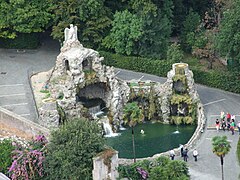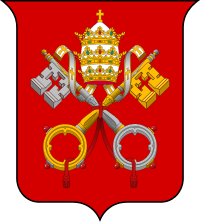Gardens of Vatican City
| Gardens of Vatican City | |
|---|---|
|
Vatican Gardens | |
 | |
| Type | Botanical |
| Location | Vatican City |
| Coordinates | 41°54.2′N 12°27.2′E / 41.9033°N 12.4533°E |
| Area | 23 hectares (57 acres) |
The Vatican Gardens (Italian: Giardini Vaticani) in Vatican City are private urban gardens and parks which cover more than half of the Vatican territory in the South and Northeast. There are some buildings, such as Radio Vatican, within the gardens.
The gardens cover approximately 23 hectares (57 acres) which is most of the Vatican Hill. The highest point is 60 metres (200 ft) above mean sea level. Stone walls bound the area in the North, South and West.
The gardens and parks were established during the Renaissance and Baroque era and are decorated with fountains and sculptures. There are several springs under the earth which as of 2009 are not in use. There is a wide variety of flora, and the area is considered a biotope.
There is no general public access, but guided tours are available to limited numbers.[1]
History
Tradition says that the site of the Vatican Gardens was spread with earth brought from Golgotha by Saint Helena[2][3] to symbolically unite the blood of Christ with that shed by thousands of early Christians, who died in the persecutions of Nero.[2] The gardens date back to medieval times when orchards and vineyards extended to the north of the Papal Apostolic Palace.[4] In 1279, Pope Nicholas III (Giovanni Gaetano Orsini, 1277–1280) moved his residence back to the Vatican from the Lateran Palace and enclosed this area with walls.[5] He planted an orchard (pomerium), a lawn (pratellum) and a garden (viridarium).[5]
The site received a major re-landscaping at the beginning of the 16th century,[4] during the papacy of Julius II.[6] Donato Bramante's original design was then split into three new courtyards,[6] the Cortili del Belvedere, the "della Biblioteca" and the "della Pigna" (or Pine Cone)[4][6] in the Renaissance landscape design style. Also in Renaissance style, a great rectangular Labyrinth, formal in design, set in boxwood and framed with Italian stone pines, (Pinus pinea) and cedars of Lebanon, (Cedrus libani).[2] In place of Nicholas III's enclosure, Bramante built a great rectilinear defensive wall.[6]
Today's Vatican Gardens are spread over nearly 23 hectares (57 acres), they contain a variety of medieval fortifications, buildings and monuments from the 9th century to the present day, set among vibrant flower beds and topiary, green lawns and a 3 hectares (7.4 acres) patch of forest. There are a variety of fountains cooling the gardens, sculptures, an artificial grotto devoted to Our Lady of Lourdes, and an olive tree donated by the government of Israel.[7]
Gallery
-

Part of the Vatican Gardens
-
Fontana dell'Aquilone in the Vatican Gardens
-

Armenian cross-stone (Khatchkar) inside the Vatican Gardens
-

Vatican Gardens
-

Palace of the Governorate of Vatican City State
-

Vatican Gardens
See also
References
Notes
- ↑ Vatican Gardens Tour - Vatican Museum Rome
- ↑ 2.0 2.1 2.2 "MO Plants: Vatican Gardens". © 2006 MoPlants.com. Archived: 8 March 2012.
- ↑ Patron saint of archaeologists
- ↑ 4.0 4.1 4.2 "Al Pellegrino Cattolico: The Vatican Gardens". © 2008 Al Pellegrino Cattolico s.r.l. Via di Porta Angelica 81\83 (S.Pietro) I- 00193 Roma, Italy. Retrieved 2008-11-21.
- ↑ 5.0 5.1 "Official Vatican City State Website: A Visit to the Vatican Gardens". © 2007-08 Uffici di Presidenza S.C.V. Retrieved 2008-11-21.
- ↑ 6.0 6.1 6.2 6.3 "Vatican Gardens". © 2008 Cooperativa IL SOGNO, Viale Regina Margherita, 192 - 00198 ROMA. Retrieved 2008-11-21.
- ↑ Hofmann, Paul (6 July 1997). "Glorious Gardens of the Vatican". New York Times. Retrieved 2013-03-01.
Bibliography
- Nichols, Fiona (1 August 2006). Rome and the Vatican. New Holland Publishers. pp. 85–. ISBN 978-1-84537-500-3. Retrieved 4 March 2010.
- Ricci, Corrado. "Vatican: Its History Its Treasures" Contributor Ernesto Begni. © 2003 Published by Kessinger Publishing, ISBN 0-7661-3941-7, ISBN 978-0-7661-3941-1
 This article incorporates text from a publication now in the public domain: Herbermann, Charles, ed. (1913). Catholic Encyclopedia. Robert Appleton Company.
This article incorporates text from a publication now in the public domain: Herbermann, Charles, ed. (1913). Catholic Encyclopedia. Robert Appleton Company.
Sources
The initial version is based upon the article it:Giardini Vaticani of the Italian language edition of Wikipedia. Data concerning the measures of lengths were taken from the article de:Vatikanische Gärten of the German language edition of Wikipedia.
External links
| Wikimedia Commons has media related to Giardini Vaticani. |
- Official website
- The Vatican: spirit and art of Christian Rome, a book from The Metropolitan Museum of Art Libraries (fully available online as PDF), which contains material on the gardens (pp. 155-164)
| |||||||||||||||||||||||||||||||||||||



